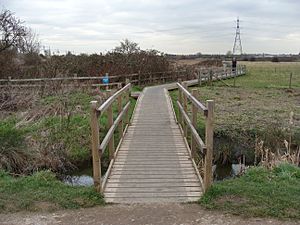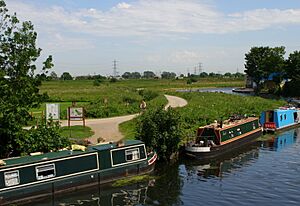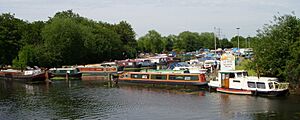Walthamstow Marshes facts for kids
| Site of Special Scientific Interest | |

Boardwalk across an environmental protection area
|
|
| Area of Search | Greater London |
|---|---|
| Interest | Biological |
| Area | 36.7 hectares |
| Notification | 1985 |
| Location map | Magic Map |
Walthamstow Marshes is a special natural area in Walthamstow, London. It covers 36.7 hectares (about 90 acres) and is a protected Site of Special Scientific Interest. This means it's a very important place for wildlife and nature. A long time ago, this land was known as "lammas land." This was common land where local people grew crops and let their cattle graze. Today, it's a wonderful place to explore nature right in the city!
Contents
Aviation History: First British Flight
Did you know that Walthamstow Marshes played an important part in aviation history? In 1909, a brave airplane designer named Alliott Verdon Roe made history here. He flew the first ever all-British powered flight across the marsh! His earlier plane had a French engine, but this one was truly British.
After his amazing flight, Alliott Verdon Roe went on to create the famous Avro Company with his brother in Manchester. You can still see a special blue plaque on a railway arch nearby. This plaque marks the spot where he had his workshop and reminds everyone of his incredible achievement.
Exploring the Geography of the Marshes
The Walthamstow Marshes are located within the Lee Valley Park. The River Lee forms one of its borders, separating it from the London Borough of Hackney. To the south, you'll find the Leyton Marshes. To the north are parts of the Tottenham Marshes, some of which are now the Banbury Reservoir.
North of Coppermill Lane, there are several linked reservoirs. These include Lockwood, High Maynard, Low Maynard, Walthamstow Reservoirs, East Warwick, and West Warwick. The 90.7-acre area of Walthamstow Marshes south of these reservoirs was lucky. It avoided being built on or used for digging up gravel. This allowed it to remain a peaceful home for wildlife. Only railway lines crossed it in 1840 and 1870.
The marshes are one of the last remaining examples of natural wetland in Greater London. They have many different types of plants that grow in floodplains. You can find various kinds of grasslands, sedge marsh, reed swamp, and areas with tall herbs. Because of this wide variety of habitats, many plant and insect species live here that are rare in the London area.
Wildlife: Insects and Birds
The marshes are home to several insect species that are not often found in London. These include the Essex skipper butterfly (Thymelicus lineola). You might also spot an uncommon parasite fly called Ligeria angusticornis. Another rare visitor is a type of moth known as Shoeribius micronellus. Sometimes, the nationally endangered marsh warbler even breeds here.
The marshes are also a great place for birdwatching. You can see many birds that love marshland habitats. These include the reed bunting, and different types of warblers like the reed warbler, sedge warbler, and willow warbler. In winter, many different birds visit the marshes and nearby reservoirs. In autumn, you can often see flocks of finches feeding on the seeds of the tall plants.
Split Leaf: A Special Sculpture
As you enter the marshes, you'll see a sculpture called Split Leaf. It was created by artist Jon Mills. This artwork was made in spring 2003 with the help of students from Coppermill Primary School and Mission Grove Primary School. It was part of a program called "Take pART." The sculpture was designed to be a welcoming gateway to the park and the beautiful marshes beyond.





